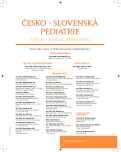-
Medical journals
- Career
Cytogenetics of acute leukemias in childhood
Authors: D. Ilenčíková
Authors‘ workplace: 2. detská klinika LFUK a DFNsP, Bratislava, prednosta prof. MUDr. L. Kovács, DrSc., MPH
Published in: Čes-slov Pediat 2015; 70 (2): 93-98.
Category: Acute leukemias in children
Overview
Acute childhood leukemias are characterized by recurrent numerical and structural chromosomal anomalies, which are specifically associated with diagnosis and prognosis of childhood acute lymphoblastic leukemia (ALL) and acute myeloid leukemia (AML). The identification of chromosomal aberrations is clinically very important for oncological praxis to distribute patients in to the diverse risk groups. However there have been a group of patients with undetectable genetic marker, possibly due to the low resolution of used genetic screening tools.
This review present the most chromosomal aberrations associated with pediatric ALL and AML and their clinical significance, as well as the current technologies used for their identification.Key words:
cytogenetic analysis, acute lymphoblastic leukemia, acute myeloid leukemia
Sources
1. Harrison CJ. Cytogenetics of paediatric and adolescent acute lympho-blastic leukaemia. Br J Haematol 2009; 144 : 147–156.
2. Nachman JB, Heerema NA, Sather H, et al. Outcome of treatment in children with hypodiploid acute lymphoblastic leukemia. Blood 2007; 110 : 1112–1115.
3. Paulsson K, Johansson B. High hyperdiploid childhood acute lympho-blastic leukemia. Genes Chromosomes Cancer 2009; 48 : 637–660.
4. Vrooman LM, Silverman LB. Childhood acute lymphoblastic leukemia: update on prognostic factors. Curr Opin Pediatr 2009; 21 : 1–8.
5. Harrison CJ, Foroni L. Cytogenetics and molecular genetics of acute lymphoblastic leukemia. Rev Clin Exp Hematol 2002; 6 : 91–113.
6. Harrison CJ. The detection and significance of chromosomal abnormalities in childhood acute lymphoblastic leukaemia. Blood Rev 2001; 15 : 49–59.
7. Usvasalo A, Raty R, Knuutila S, et al. Acute lymphoblastic leukemia in adolescents and young adults in Finland. Haematologica 2008; 93 : 1161–1168.
8. Raimondi S, Heerema N. Cytogenetics in children, adolescents, joung adults with ALL and AML. In: Cairo MS, Sherrie L. Hematological Malignancies in Children, Adolescents and Young Adults. New York: Medical College, Word Scientific 2012 : 103–119. ISBN 978-981-4299-60-2.
9. Braoudaki M, Tzortzatou-Stathopoulou F. Clinical cytogenetics in pediatric acute leukemia: An update. Clin Lymphoma Myeloma Leuk 2012; 12 (4): 230–237.
10. Martinez - Leblanc T, Berger R. Molecular cytogenetics of childhood acute myelogenous leukaemias. Eur J Haematol 1997; 59 : 1–13.
11. Nordgren A. Hidden aberrations diagnosed by interphase fluorescence in situ hybridisation and spectral karyotyping in childhood acute lymphoblastic leukaemia. Leuk Lymphoma 2003; 44 : 2039–2053.
12. Mrózek K, Heerema NA, Bloomfield CD. Cytogenetics in acute leukemia. Blood Rev 2004; 18 : 115–136.
13. Luna-Fineman S, Shannon KM, Lange BJ. Childhood monosomy 7: epidemiology, biology, and mechanistic implications. Blood 1995; 85 : 1985–1999.
14. Le Beau MM, Espinosa R 3rd, Davis EM, et al. Cytogenetic and molecular delineation of a region of chromosome 7 commonly deleted in malignant myeloid diseases. Blood 1996; 88 : 1930–1935.
15. Gamerdinger U, Teigler-Schlegel A, Pils S, et al. Cryptic chromosomal aberrations leading to an AML1/ETO rearrangement are frequently caused by small insertions. Genes Chromosomes Cancer 2003; 36 : 261–272.
16. Cheng CK, Li L, Cheng SH, et al. Transcriptional repression of the RUNX3/AML2 gene by the t(8;21) and inv(16) fusion proteins in acute myeloid leukemia. Blood 2008; 112 : 3391–3402.
17. Burjanivova T, Madzo J, Muzikova K, et al. Prenatal origin of childhood AML occurs less frequently than in childhood ALL. BMC Cancer 2006; 6 : 100–107.
18. Bacher U, Schnittger S, Haferlach C, et al. Molecular diagnostics in acute leukemias. Clin Chem Lab Med 2009; 47 : 1333–1341.
19. Olde Nordkamp L, Mellink C, van der Schoot E, et al. Karyotyping, FISH, and PCR in acute lymphoblastic leukemia: competing or complementary diagnostics. J Pediatr Hematol Oncol 2009; 31 : 930–935.
20. Lazic J, Tosic N, Dokmanovic L, et al. Clinical features of the most common fusion genes in childhood acute lymphoblastic leukemia. Med Oncol 2010; 27 : 449–453.
21. Mrózek K, Heinonen K, Bloomfield CD. Clinical importance of cytogenetics in acute myeloid leukaemia. Best Pract Res Clin Haematol 2001; 14 : 19–47.
22. Ilencikova D, Kolenova A. MLL gene alterations in acute myeloid leukaemia (11q23/MLL+ AML). In: Siregar Y (ed). Oncogene and Cancer – From Bench to Clinic. InTech 2013 : 328–352. ISBN: 978-953-51-0858-0.
23. Felice MS, Gallego MS, Alonso CN, et al. Prognostic impact of t(1;19)//TCF3-PBX1 in childhood acute lymphoblastic leukemia in the context of Berlin-Frankfurt-Münster-based protocols. Leuk Lymphoma 2011 Jul; 52 (7): 1215–1221.
Labels
Neonatology Paediatrics General practitioner for children and adolescents
Article was published inCzech-Slovak Pediatrics

2015 Issue 2-
All articles in this issue
- Leukemias in children in the 21st century
- Aetiology of childhood ALL and AML, molecular genetics and minimal residual disease
- Immunophenotyping and other applications of flow cytometry in acute leukemias
- Cytogenetics of acute leukemias in childhood
- Acute lymphoblastic leukemia
- Acute myeloid leukemia in children
- Hematopoietic stem cell transplantation in therapy of acute lymphoblastic leukemia in children
- Czech-Slovak Pediatrics
- Journal archive
- Current issue
- Online only
- About the journal
Most read in this issue- Acute myeloid leukemia in children
- Acute lymphoblastic leukemia
- Leukemias in children in the 21st century
- Immunophenotyping and other applications of flow cytometry in acute leukemias
Login#ADS_BOTTOM_SCRIPTS#Forgotten passwordEnter the email address that you registered with. We will send you instructions on how to set a new password.
- Career

